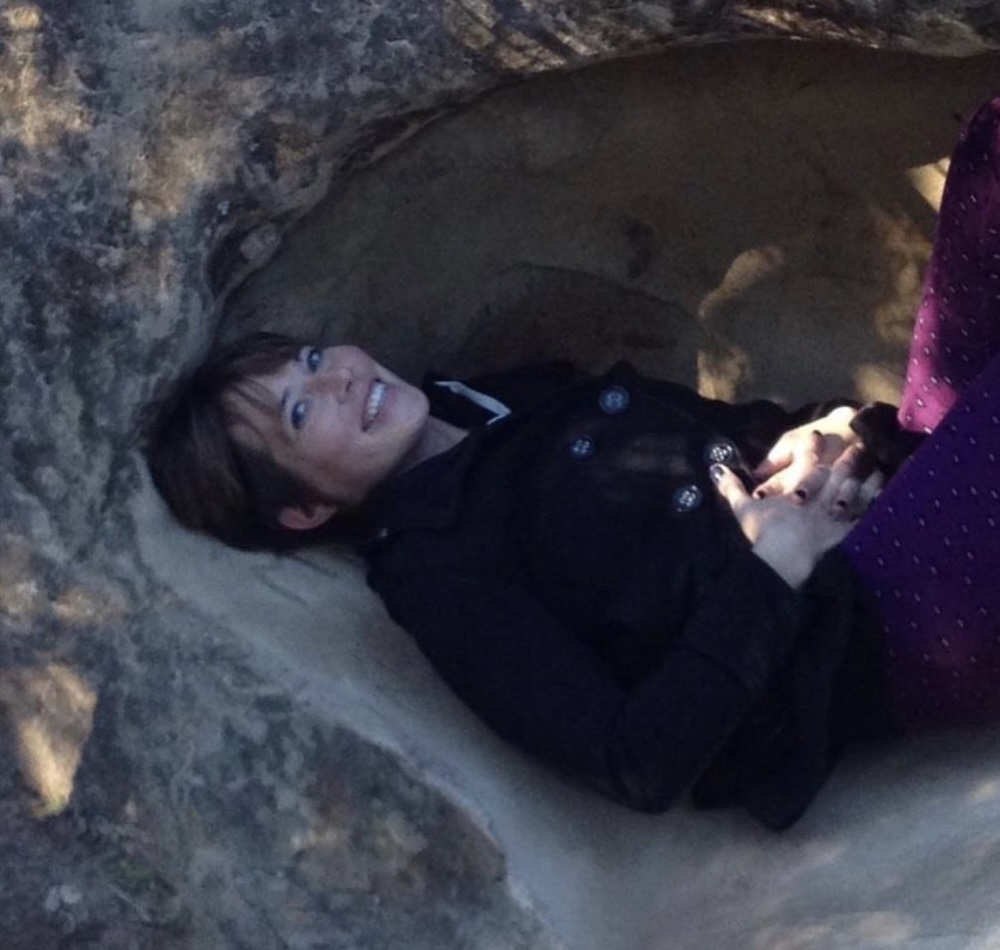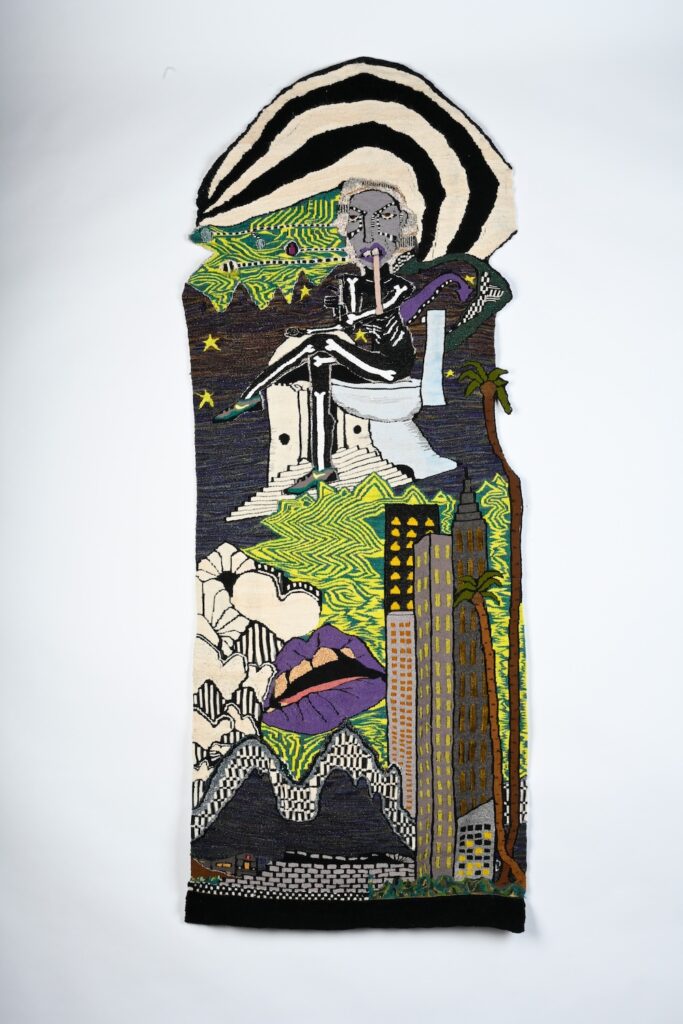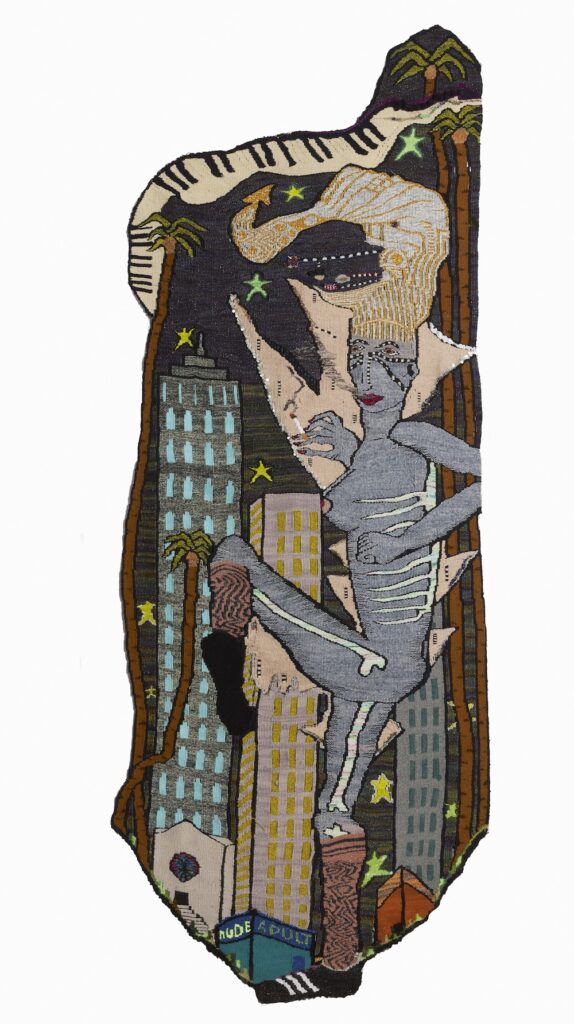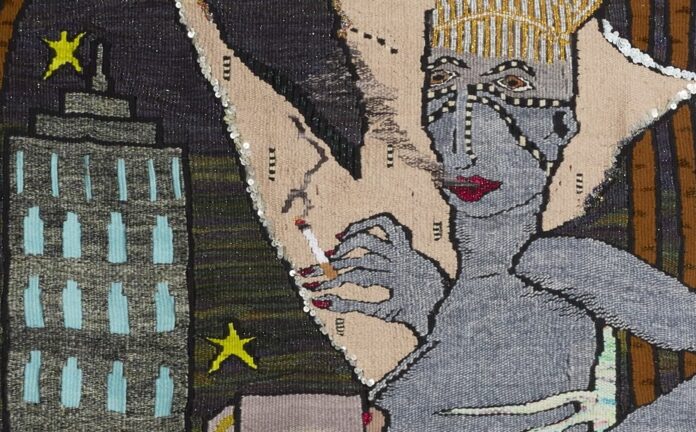Textile artist Dance Doyle is weaving their own version of Tales from the City, based on stories derived from experiences that unfold around life in Oakland. They extract many of their ideas from walking the city streets, processing every visual they encounter.
“Urban settings, color combos in unexpected places and in nature, wild conversations, stories told to me, lived experiences, sex, trauma, poetry, friends, foes, 1990s movie posters, the natural and the plastic world around us inspire me. And, remembering when an ex told me back in my 20s that it wasn’t going to get any better than dating them, and life did and has continued to, every day,” Doyle told 48hills.
Just two months old when their parents moved to Oakland, Doyle spent nine months in New York as artist-in-residence at Brooklyn’s Textile Arts Center in 2019—but other than that, they are Bay Area through and through. They attended both the Convent of the Sacred Heart High School and Pacific Heights in San Francisco, Maybeck High School in Berkeley, and Skyline High School in the Oakland hills.

As a liberal arts student at City College in San Francisco in 2004, trained originally in ceramic sculpture with Don Santos, Doyle went on to earn a BFA in textiles at San Francisco State University in 2010. In 2023, Doyle completed an MFA at California College of the Arts.
Doyle says what they enjoy most about living in the Bay Area is the scenery, the rich diversity of people, and the unbeatable weather. They currently reside in the Grand Lake neighborhood of North Oakland. Having received a graduate fellowship with Headlands Center for the Arts in Sausalito for 2023-’24, Doyle now maintains a space in Oakland near Piedmont Avenue where they create their textile pieces. They say that becoming a tapestry artist allowed them to channel difficult emotions into something tangible they could not express with words.
“When I started this journey, turning tapestry into this creative visual journal about my struggles became transformative for me. Visually re-creating my narratives accords me with a sense of power I thought had vanished. I’ve been wildly invested in this work ever since,” Doyle said.
Doyle begins their small, three-dimensional tapestries by drawing a small sketch of what they want a piece to look like, pinning it to the castle—the central part of the loom that holds the shafts in place—of their four-harness floor loom, and beginning to weave. Designs are worked out as they go.

“There are blank spaces in the design so that I can weave free form, like I’m channeling something I don’t yet know about. My fingers are directly turning expression and thought in real-time into an unwritten woven verse,” they said. They describe their work as provocative, relevant, and unruled—and sometimes unruly.
Upon arriving at San Francisco State, Doyle was in need of one more studio class for their major and selected a course in textiles by chance.
“Textiles changed me at a time when I needed a tether to something beautiful. Things were really hard back then. I was homeless that year. I was sleeping in BART and in people’s backyards in Berkeley by the end of my senior year. Crazy times. Textiles, and specifically the work in tapestry, was the motivation I needed to change my life,” Doyle said.
They add that because there was no coursework specific to tapestry within the Textiles program at SFSU—they were learning the ropes on their own with very little guidance. Left alone to experiment and take risks within the medium, Doyle’s work blossomed.
“I think my professors were just happy I was finally focused on something. I was a little feral at that time,” they said.
Doyle wants to steer people away from thinking of tapestries as mere depictions of unicorns and dark castles in Europe. For the last five years, their work has centered on research they have done on the homeless, addiction, and mental health illness experiences they and so many others have experienced.

“It is because of my own history of dealing with homelessness, mental health, and addiction over a decade ago that I tell these abrasive narratives. The subject matter in my work can spur hard dialogue about age-old stigmas and humanity which for me makes the work relevant and worthwhile to un-earth, peel away, and explore,” Doyle said.
“I’ve anonymously interviewed adults and youth who are out there about the stigma they’re experiencing and the civic/non-profit resources available to them including affordable/subsidized housing, food, toiletries, ability to bathe, and access to medical/mental health treatment. My tapestries feature portraits and visual testimonials of what it’s like in that environment day-to-day. I am currently creating a series on the controversial topic of harm reduction as a social and political movement,” they said.
Doyle will soon have a show at the graduate fellowship exhibition that will open July 12 at the Institute of Contemporary Art San Francisco in the Dogpatch neighborhood. “The other graduate fellows are wildly talented so it should be a great exhibition,” they said.
They do have serious questions about the way this city supports its artists. For example, they query, why has there never been a San Francisco Foundation for the Arts?
“There is one in Brooklyn (Art in Dumbo) that has existed since the 1970s, and the organization supports an endless list of artists per year via grants, access to lectures, workshops, professional development, mentorship, portfolio reviews, job opportunities, events, shows, and community gatherings. I think it may be time for that here, as a tremendous amount of Bay Area artists are moving away for reasons like the high cost of living coupled with the lack of institutional support offered,” they said.

In the meantime, Doyle shares their knowledge and expertise with others by teaching art to elementary and high school kids at Studio One Art Center in Oakland, where they have worked since 2015. Among Doyle’s class offerings are art-to-wear, papier-mâché sculpture, and mixed media weaving.
They emphasize that creating tapestries can be a way of turning stories into art, similar to painting.
“I’ll explain it this way: A painter will take a canvas, which is a woven structure, and add paint to it. I create the narrative with the woven structure itself, using dyed fiber instead of paint,” they said.
From the very beginning, Dance Doyle has felt that every time they take their seat at the loom, they are perfecting their craft. For the last eight years, they have been focusing on refining their technique and the long journey of that evolution is tangible to the artist.
“I love what this art form has done to me,” Doyle said. “I’m more patient, meticulous, relaxed, and grounded. I feel I’m always ready to learn more. I hope I remain that way my whole life.”
For more information, visit their website at dancedoyle.com.






